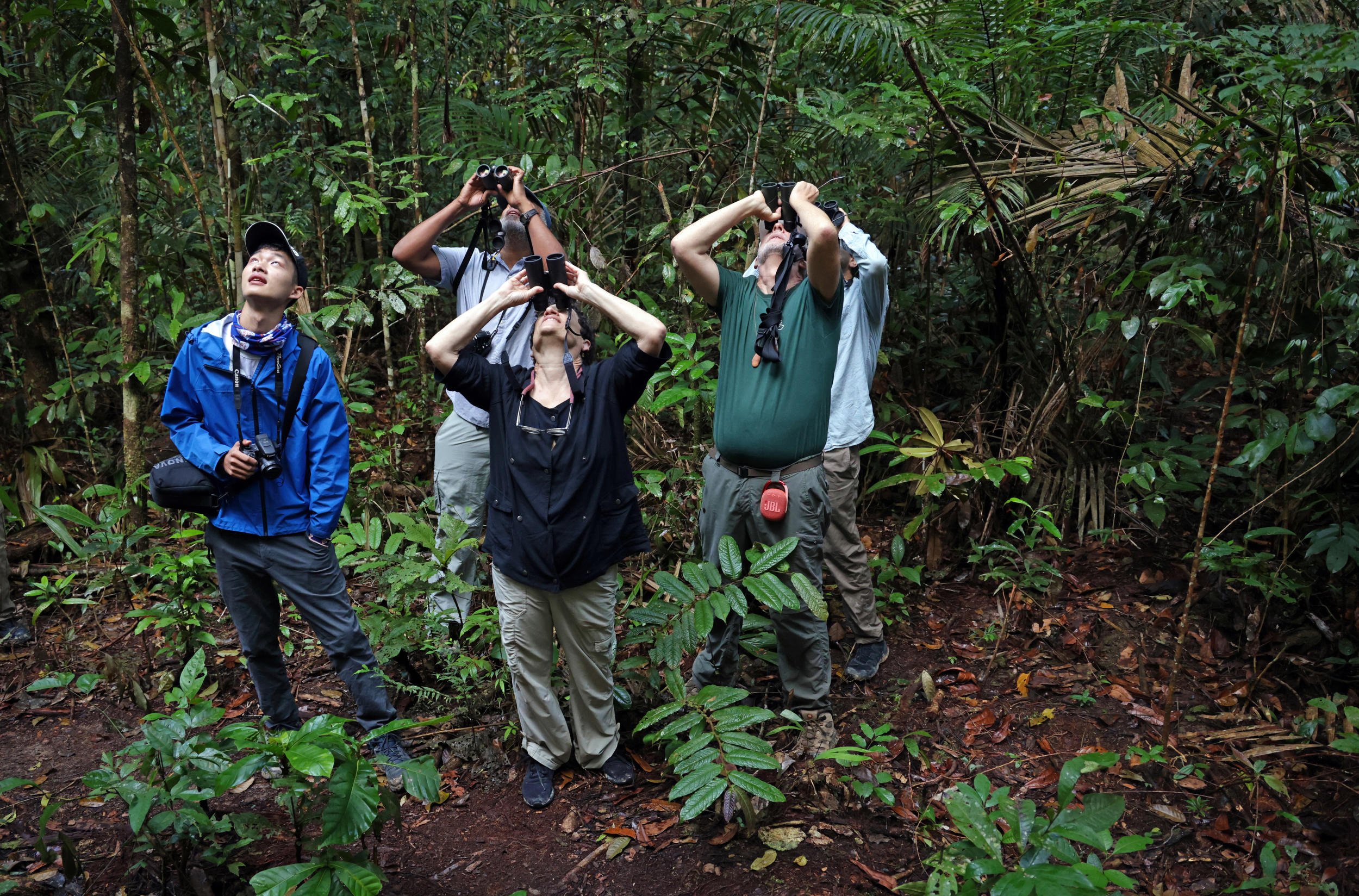CAMP 41, Brazil — The Harvard Amazon Rainforest Immersion reminded Nick Kowalske of the dangers of complacency.
Over the 10-day research and teaching intensive hosted this summer by the David Rockefeller Center for Latin American Studies (DRCLAS), the senior integrative biology concentrator spotted and identified 121 species while exploring the Brazil state of Amazonas. Highlights include a toco toucan, red-billed pied tanager, and neotropic cormorant, all documented on eBird.org.
As a long-time birder, he knew it was easy to get spoiled by the abundance of avian life. “I frequently catch myself saying, ‘Oh, it’s just a cormorant,’” said Kowalske, who completed a DRCLAS biodiversity internship earlier in the summer at Instituto Terra Luminous near São Paulo. “But I try to remain excited about the common things.”
With a sharp eye and an even sharper mind for the region’s biodiversity, the Dallas native’s knowledge proved an asset to anybody with binoculars. Some of it was acquired while volunteering in Ecuador a few summers ago. And some came from studying up on the Amazon’s bird life before the big trip.
His ecological education, however, began much earlier. “It started when I was 4 or 5 years old,” Kowalske said. “Every night I would make my mom sit and read the ‘Encyclopedia of Animals’ with me.”
Co-sponsored by the Salata Institute for Climate and Sustainability, the August immersion was organized by the DRCLAS Brazil Office with help from Amazonas State University (UEA) and Academia Amazônia Ensina. Twenty-one students and young academics from Harvard and universities across South America explored the world’s most diverse biome while learning from locals about the Amazon’s beauty and climate, economy, and public health challenges.
Bird lovers were pleased from Day One, which brought the group to the top of a 138-foot observation tower at the Museu da Amazônia (Musa), a sprawling natural history museum and rainforest reserve on the outskirts of Manaus, the capital of the state of Amazonas.
“Looking down into the canopy and seeing toucans and macaws flying everywhere was just ridiculous,” said Nicholas Arisco, M.S. ’18, Ph.D. ’23, a postdoctoral fellow at the Harvard T.H. Chan School of Public Health who fell hard for birding during the immersion.
Also memorable was the two-night stay at Camp 41, a far-flung research station and preserved rainforest fragment located about 70 miles north of Manaus. For ornithologist Scott V. Edwards, professor and chair of the Department of Organismic and Evolutionary Biology, the trip’s best moment concerned a yellow-headed vulture that perched itself above the dining shed.
“I’m not so much into the rarity of things,” explained Edwards, who also serves as curator of ornithology at the Museum of Comparative Zoology. “I’m more into getting a good view.”
Camp 41 proved especially prime for fans of birdsong. “It’s a lot harder to see stuff here in the woods, but it’s fun to just listen,” said ornithologist Mario Cohn-Haft, the group’s host at the site as well as a member of the ecology faculty at the Brazilian National Institute for Amazon Research (INPA) in Manaus.
Participants gathered at picnic tables one morning before dawn, with Cohn-Haft immediately recognizing the low-pitched hoot-hoot of a blue-crown motmot. As the sun rose, the chorus grew to include a black nunbird, red-billed woodcreeper and chestnut-rumped woodcreeper, among many others Cohn-Haft identified by ear.
“I’m sure we’ve heard well over 50 species of birds today,” he said that night.
At Camp 41, Kowalske added more than 40 species to his tally, including three varieties of manakin, a swallow-tailed kite, and a whiskered flycatcher with its baby in their nest. “It’s great to see Nick in his element,” Edwards said. “I’ve been very impressed.”
A whiskered flycatcher.
Photo by Nick Kowalske
For Kowalske, the best birding was found at São Francisco das Chagas do Caribi, a small community of eco-friendly artisans and planters on the Rio Uatumã. “We saw red-and-green macaws at eye level in short palms between the houses,” Kowalske recalled. “It was an absolutely fantastic view of a magnificent bird.”
His biggest surprise unfolded next to a rural schoolhouse near Camp 41. Kowalske and Arisco moved in for a closer look at some açaí trees with a flock of toucans, including a few green aracari and one channel-billed toucan.
Then Arisco pointed to a far more diminutive creature in the treetops.
Kowalske shrugged it off at first when asked what it was. “I said ‘Oh, it’s another flycatcher,’” he recalled with a grin. “I didn’t even really look. And complacency is evil … so don’t do that.”
When he zoomed in with his Nikon DSLR, Kowalske recognized it was a rare and “legendary sighting” called a dusky purpletuft. The bird was last spotted around Camp 41 by Cohn-Haft in 1987 when he first arrived for a bird-monitoring internship.
“These birds are known primarily from the Guyanas and Suriname, but their range, we now know, extends farther south,” Kowalske rattled off. “It was super cool to see — even if it was just a little bird in the canopy.”
Related story
-
 Science & Tech
Science & TechJourney to a key front in climate-change fight
Amazon immersion fosters partnerships, offers students, researchers hard look at threats to economic security, environment of rainforest as Earth warms
long read
Source link

